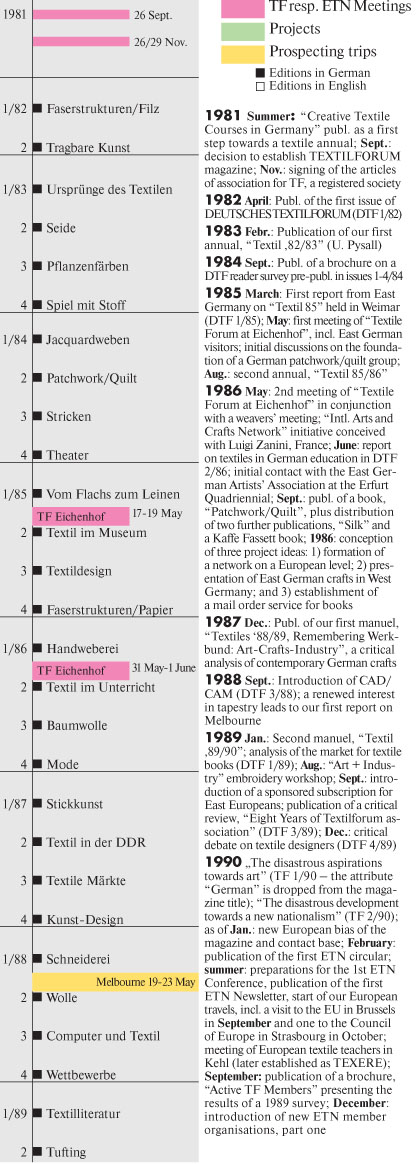 |
The Co-founders of Textile Forum magazine and the European Textile Network (ETN), Beatrijs Sterk and Dietmar Laue, consider themselves happy losers:
We continue to derive happiness from our engagement in a subject matter that we know to be the expression of an existential human need, and one that has undergone admirable cultural manifestations at every stage of human history. A concern for textiles has been as important as concerns for shelter, food, health and the ability to communicate. The 19th century architect Gottfried Semper once wrote: “Textile art merits absolute supremacy as it has been revealed to be the original art, as it were, and seems to be an entirely natural phenomenon, whereas all other arts borrow their types and symbols from textile art.” A quote by Patrice Hugues, a present-day French artist and author, manifests the full drama that governs the theme of textiles: “How could it happen that one of mankind‘s richest and most wide-spread means of expression was gradually lost, sinking into such insignificance? And how could this happen in the Western world? What are the reasons? And how great is the damage we have suffered as a result? It is directly related to certain shortcomings, to the lack of connection we feel between our bodies and our lives that are ruled by technology and intellect. Our inability to interact with one another spontaneously and freely also stems from this.
We feel losers in the sense that we have attempted to do something about the irrelevance of textiles in our society. Eight years after the launch of our magazine, then still named “Deutsches Textilforum”, we were on the verge of abandoning our editorial work, and announced this step in a feature entitled “Acht Jahre Textilforum e.V. (Eight Years of Textilforum association)” in DTF 3/89. Subsequently the Berlin wall fell, and by the end of that year all the barriers separating us from Eastern Europe had disappeared. This gave us a boost of energy. The resurgence of nationalism in Germany prompted us to search for ways to overcome the voicelessness that existed between the west and east of our continent, at least in our sphere of influence, textile culture.
In February 1990 we approached more than 200 contacts in former Eastern Bloc countries, inviting them to enter into a dialogue with us and our colleagues in Western Europe. Later this led us to form the European Textile Network (ETN); in 1991, immediately after our first conference held in Erfurt, a university city in former East Germany, we produced a kind of manifesto outlining what ETN members considered to be our joint tasks in the field of textile culture.
In the European Union we encountered EURATEX, a pressure group of the European textile and clothing industry that exclusively deals with the economic concerns of our field. In those days, the EU as such did not have any authority on cultural policy. However, we wished to campaign for cultural representation in the European institutions, and took two steps in that direction:
1. At the time, the Council of Europe in Strasbourg operated so-called Silk Routes in conjunction with UNESCO in Paris. We convinced the Council of Europe for these to be changed to European Textile Routes administered by ETN.
2. Once the Maastricht Treaties gave the EU a mandate for cultural policy as of 1992, we decided to provide a cultural partner for EURATEX. The NET Cultural Foundation, established jointly by ourselves and representatives from the textile industry and textile regions/cities in 1997, was meant to act in concert with that organisation and provide an economic basis for the ETN Network.
In preparation of a “Network of Textile Regions”, we outlined a range of tasks we hoped to tackle in TF 3/1994:
1) Systematic maintenance of contemporary production in textile heritage (by means of textile design collections);
2) establishment of a European summer academy for textile design (regular international exchanges of information and experiences);
3) development of an art & industry workshop programme;
4) establishment of creativity centres in each textile region to ensure further training for textile communicators in work and society; and finally,
5) introduction of international competitions to improve our everyday textile culture (textile art/design in public spaces), which would also offer recurrent PR events to stimulate public discussion.
After many unsuccessful and energy-consuming attempts, we were obliged to give up our aspirations to achieve this programme in 2007. Established in Brussels in 1997 with the express purpose of promoting ETN’s objectives, the international NET Cultural Foundation ceased operation and disappeared from the ETN internet website. It had lacked support from the European textile and clothing industry and from the respective textile cities and regions. Frequent replacement of our contacts in industry due to structural changes and a high turnover of staff in political decision-making bodies meant that we could not expect sustained support from those quarters. Measures targeting infrastructure in cultural policy on an international level are thus a matter of luck; otherwise they are immediately mired in the red tape routine, as in the instance of the European Union’s promotion of culture.
Ever since we admitted the failure of our programmatic efforts in 2007, Textile Forum magazine has merely existed as a flower in the press landscape that is easily overlooked, and ETN continues as a network with clipped wings. We look back on our own bitter experience of the social mechanisms that contribute to the irrelevance of textiles, and given the circumstances, we consider them insurmountable.
What remains to be done? This is the question we face in the 30th year of our personally fulfilling activities, and thankfully we are still searching for an answer. |